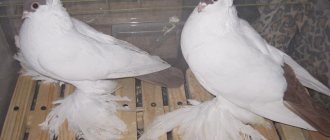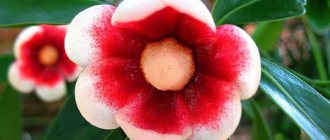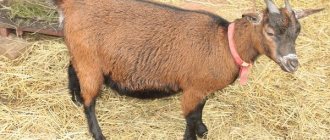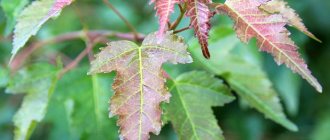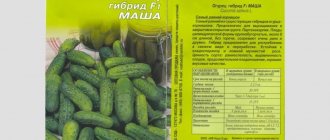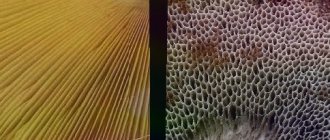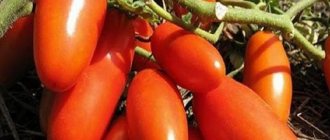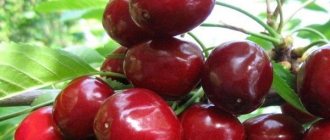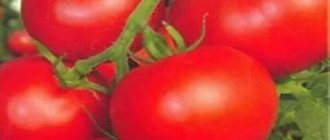Historical data
Once upon a time in Iran, only worthy people could breed pigeons - this activity was considered sacred. Iranians are the hardiest and most beautiful birds. Pigeons of this breed have become a symbol of pride and greatness; they fly in flocks, but stay alone. Iranian pigeons tend to fly slowly, but headwinds do not frighten them. They are called “fighting” for the reason that in flight, gaining altitude, the birds beat the air with their wings, creating characteristic sounds.
Iranian pigeons are descendants of Persian pigeons that decorated royal courtyards. In Persia, they began to breed them more than 1000 centuries ago. The birds were carefully selected, paying attention to such criteria as beauty, endurance, and flight altitude.
Poultry farmers tried their best to create a new breed that would meet all the stated criteria. Special competitions, where 10 birds took part, helped select the best individuals. Although there were frequent wars in this region, local residents continued to love pigeons, preserving the sacred tradition. Now bird breeding has become a sacred tradition of Iranians.
The farms where Iranian fighting pigeons are bred are owned by respected people. These pigeons are famous for their beauty and excellent flying ability. Many people love to watch these birds fly.
Story
Persian poultry farmers were the first to begin work on taming and domesticating the pigeon. That is why the history of pigeon breeding goes back thousands of years, to those unnoticed times when Sirius the Great was on the throne, and the mighty Persian Empire was able to conquer almost the whole world. The ruler took a fancy to these birds, so they soon became the main decoration of all self-respecting noble courts. But not all birds were worthy of decorating the royal court. Only particularly skilled flyers with excellent endurance and the ability to fly at great heights could receive such an honor. That is why there was no end to selection work.
In order to select the best birds, special pigeon competitions were often organized. The first mention of them dates back to the seventh century BC. They originated in Kashan, but soon became popular in many other cities. Competitions were held only in the spring with the participation of a small number of birds - from seven to eleven. In modern Iran, the number of participants has increased significantly. Now hundreds of birds are fighting for victory, demonstrating their excellent summer qualities.
Only time does not stand still. Generations and nationalities changed, the sands of centuries covered the Iranian lands, bringing with them new battles and wars. But still, some things have remained unchanged: fighting pigeons are still revered in Iran. Moreover, breeding pigeons is a sacred tradition that only the worthy can do. After all, pigeon breeding is based on pride in one’s lands and honoring the memory of ancestors.
That is why only five percent of farms now keep these beautiful pigeons. In addition, pigeons are bred mainly in the largest cities.
Selection work is bearing good fruit: now there are a huge number of breeds with a wide variety of plumage, color and body shape. But at the same time, the very structure of the body of different breeds of Iranian pigeons is not much different. It is important to note that the main efforts of breeders are aimed at improving the flight qualities of pigeons; color and plumage are often left without attention. After all, the main value of birds is the beauty and skill of flight.
Thousand-year-old dovecotes made of clay and stone are still scattered throughout Iran, reminiscent of those ancient times when man first tried to tame these birds.
Now these buildings resemble not houses for pigeons, which once housed hundreds of birds, but ancient castles. In addition, the Iranians were among the first to use pigeon droppings to fertilize land.
Exterior Features
Birds do not have clear standards, but all varieties of the breed are dominated by common features. Iranian pigeons are distinguished by their elongated body and narrowed, round or oval head. Many varieties have a smooth head with a small forelock and a long beak. The length of the wings reaches 21-30 cm, and the span is from 60 to 70 cm.
Iranian fighting pigeons boast a wide tail and long, smooth legs with no feathers. The girth of the body reaches 25-35 cm. Birds have a dense body structure, well-developed muscles, and a wide chest. The feathers fit tightly to the body.
There are a wide variety of specimens. White pigeons and birds with red, black, and yellow plumage are often encountered. Sometimes they are bluish. The most valuable are pigeons with combined colors:
- with colored head and tail;
- plain;
- with a white head and a motley body;
- with colored sides (white body, colored wings);
- with a colored head (black, yellow, red, etc.);
- with a colored tail and with a white tail;
- with colored rings located around the neck.
Typically, these breeds do not change plumage color as they age or during and after molting. Often pigeon breeders do not pay attention to plumage, breeding Iranian pigeons only in the west of Iran. They prefer birds that have a clean pattern and no marks on the body.
Diseases of birds: psittacosis
Pigeons, like people, have a lot of diseases. One of them is psittacosis. This is a viral disease that affects birds during cold periods, when the immune system is very weak. The virus is caused by chlamydia when the respiratory system is affected. Approximately 150 species of birds carry the disease. It is necessary for everyone who breeds these beautiful birds to know the symptoms and treatment of ornithosis in pigeons.
The following symptoms are characteristic of psittacosis:
- diarrhea
- drowsiness
- noticeable decrease in motor activity
- dyspnea
- lack of appetite
- poor growth
- ugly plumage
Such symptoms are typical for chicks. Adults develop a runny nose, wheezing, heavy breathing, inflamed mucous membranes and eyes that constantly water. If the main signs of infection appear, measures must be taken. Otherwise, the bird's legs and wings will be paralyzed.
If a pigeon continuously sneezes and shakes its head, this means that it needs to get rid of the fluid that is secreted from the nose. The course of the disease is accompanied by severe shortness of breath and wheezing in the nasal cavity. If you do not start treating the bird in a timely manner and do not provide the necessary care, as a result, it will die.
Most symptomatic medications for intestinal disorders have little effect. Those birds with very pronounced clinical signs are separated from other individuals, and if the condition is hopeless, they are immediately destroyed. Antibiotics are actively used for preventive purposes, and in very large dosages for several days.
During active treatment, vitamins A, D3, and E should be added to food, due to the fact that antibiotics destroy to a large extent the microflora involved in the combination of vitamins. Medicines that can give a positive effect regarding the disease in birds include ampicillin, morphocycline, and terramycin.
Read also: Keeping and feeding pigeons
It is recommended to administer up to 20 mg of antibiotic per day to healthy birds that have been in contact with infected people for 5 days.
Prevention
- For preventive purposes, returning or newly acquired birds must be quarantined.
- It is also necessary to disinfect the transport equipment of the pigeon room.
- Current disinfection is carried out with a two percent hot soda solution, a formaldehyde solution, and half a percent phenol.
- It is necessary to follow the rules on preventive measures for people from psittacosis. It is strictly forbidden to feed birds by mouth. It is recommended to carry out cleaning of the dovecote in compliance with all safety precautions. Be sure to wear gloves and a respirator while cleaning.
Danger to humans
- If you come across a lethargic, absolutely inactive bird on the street that does not move when a person approaches, then you should worry, as the virus spreads by airborne droplets.
- In addition, you can become infected in other ways. Quite often pigeons gather on the windowsill, which may turn out to be sick. When a window is opened, frightened pigeons suddenly fly in and fly close to your face, which can become a method of infection.
- The main danger is that the disease can be completely asymptomatic, although the pigeon is already infected.
Signs of a viral disease in humans are cough, chills, soreness in the respiratory tract, muscle pain, and high fever. The symptoms are similar to pneumonia, so the disease is severe; treatment usually lasts several months. For this reason, you need to be extremely careful with sick pigeons.
The disease has been known for a very long time. It takes away a huge number of birds.
- At the beginning of the disease, the bird becomes lethargic, sleepy, loses appetite and does not even drink water. If a whirligig is suspected, the pigeon must be isolated and a doctor must be called to establish a diagnosis.
- Basically, the disease develops very quickly, but occasionally a chronic disease occurs. Then the symptoms are not noticeable for about a month. During this period, the pigeon feels well and has a normal appearance.
- There are two types of twirler. The first is characterized by a pathology of the nervous system, while the second affects internal organs.
- Symptoms of the neurological type are expressed in the fact that the bird becomes lethargic, loses appetite, and practically does not fly. Severe diarrhea occurs, hoarse breathing intermittently, the pigeon is constantly thirsty, and internal bleeding appears.
Based on the initial symptoms, chickenpox can be confused with other infectious diseases and it is impossible for the breeder to make a diagnosis. Diagnosis of the disease is possible only through laboratory tests.
The stages of the disease are divided into the following:
- Lethargy, apathy, unsteady gait, but good appetite. After a short time, light spots form on the beak, the eyes become red, and the feathers take on an unkempt appearance. The pigeon weakens before our eyes and moves less.
- The appearance of severe mucous diarrhea, gray in color with greenery. The nervous system is gradually affected. The bird does not eat anything, but consumes a lot of water. Convulsions appear, orientation is lost.
- The last stage is characterized by damage to the brain, the pigeon’s neck becomes bent, the head lifts up and falls from time to time, thirst stops, the head begins to rotate in a circle, which is where the name of the disease comes from.
If symptoms of whirling are detected, treatment must be started in the first two days, otherwise the bird will die.
In no case should you self-medicate pigeons; this will not bring any benefit, but can cause harm. After diagnosis, the veterinarian will prescribe treatment:
- First, the sick bird must be isolated, and the place where it was located must be thoroughly treated with bleach or formaldehyde.
- Several types of medications are used in therapy: nootropic, prebiotics, antiviral, vitamins.
- The most commonly used are Fosprenil or Immunofan. They are powerful antiviral agents, which include interferon, an indispensable tool for maintaining immunity. The drugs can be administered intramuscularly or added to liquids.
- The medicine Fosprenil helps with vertigo. The nootropic Piracetam is definitely used, which helps relieve pronounced neurological symptoms. Before taking, you need to open the capsule and divide the powder from it into 4 parts. Then one of the parts must be dissolved in water and given to the bird.
- An important additive to pigeon food are special vitamins. Among them it is worth noting Vikasol, Katazol, Galavit. Such useful supplements will increase the body’s defenses and help cope with a serious illness in a shorter time.
- In addition, to get rid of intoxication, veterinarians recommend including enterosorbents and prebiotics (Linex, Karsil) in the birds’ menu.
- Experienced professionals recommend the medicine Pulsoceril as a highly effective remedy.
Since sick pigeons do not want to eat or drink on their own, it is necessary to force them to drink. Otherwise, the pigeons will die from dehydration.
Flight specifics
Iranian fighting pigeons fly slowly and calmly. A mandatory indicator of the summer is a fight with further entry into the post. Birds also show their flight qualities especially well when flying against the wind. A distinctive characteristic is the ability of pigeons to rise to a height that flies can reach, then they hang there for a couple of minutes.
Birds of this breed reveal themselves with a characteristic fight: it is moderate, and the stand itself must be fixed for several seconds. The noise of battle can be clearly heard even from a great height. Pigeon breeders value the breed for its long summer - birds can fly over distances for 3-10 hours.
Breed overview
Origin story
Ancient Persia was one of the first to domesticate pigeons. One of the earliest mentions of this dates back to the reign of Sirius the Great. Iranian pigeons were the attraction of any noble court and were bred in the empire for a thousand years. In those distant times, the main features that a worthy flyer should have were endurance, combat and the ability to fly at high altitude. For this purpose, constant selection work was carried out.
What varieties are there?
In the course of their work, breeders managed to develop many varieties of Iranian pigeons. Depending on the place of origin of the breed, pigeons have different plumage colors and characteristics.
Tibriz pigeons
This subspecies is the most common in the western lands of Iran. Birds have an elongated head and an elongated body. The direct relatives of these pigeons are considered to be the Baku flyers. Residents of Iran note that it is impossible to fully know how this variety was bred. Even the most experienced pigeon fancier, who has many years of experience, can always learn something new about the ancient bird.
Headed
A distinctive feature of headed Iranian pigeons is the contrasting color of the plumage on the head. The birds are characterized by a snow-white shade of feathers on the body, and the plumage on the head and neck is dark in color - ranging from light brown to black. This species is especially valued by poultry farmers, due to the fact that they have difficulty making contact with humans and cause difficulties in taming, but at the same time, having achieved results, the birds will reward the pigeon breeder with a beautiful pole-like flight.
Tehran high flyers
Tehran pigeons are a popular and famous species. The birds are very similar to the hawk. These birds have an impressive wingspan - it can reach 70 cm. The animals have a rounded head and a short beak. There are individuals with different colors and patterns.
Hamadan fighting cosmachi
The place where the variety of Iranian pigeons was bred was the northwestern part of Iranian lands, more precisely the Hamadan province, which is how the birds got their name. Pigeons have long feathers on their legs (up to 20 cm) - this decoration is considered the most important in their appearance.
Iranian breeders were able to develop many lines of representatives of this subspecies. There are specimens that surprise with the presence of a forelock on the head, a long beak, and the color of the feathers. There is nothing strange in this, since breeding work has lasted for thousands of years.
Cheeked (karages)
Chick pigeons are a cross between Tibriz and Tehran birds. Iranians have a unique pattern on their plumage, which makes the variety recognizable among other breeds. The main color of the feathers is white, but the cheeks and head can be red or yellow. Cheeky Iranians have a slender body and a smooth head.
Fighting pigeons: Iranian breed.
Iranian pigeons are one of the oldest pigeon breeds. Even in ancient Persia, pigeon breeders highly valued this breed. Historical information about Iranian pigeons dates back to the 7th century BC.
The first mention of Iranian pigeons dates back to the 7th century AD
The breed originated in the city of Kashan, in the central part of the ancient state. The breed of pigeons quickly became popular in other cities of Ancient Persia. But only the very rich nobility and Persian rulers could buy pigeons.
To this day, pigeon breeding is a sacred tradition that only worthy people can engage in. That is why in modern Iran only 5% of poultry farms are engaged in breeding and selling pigeons.
Features of pasture and selection
Iranian fighting pigeons are not used to flying in a flock. Every pigeon is an individualist. Some specimens are capable of freezing high in the air for several minutes. By providing excellent living conditions and a balanced diet, specially trained pigeons will become not only strong, but also hardy, but their flight duration will only increase.
The average flight duration is from 4 to 8 hours. Birds that fly for less than 3 hours are culled.
A number of requirements are put forward for young animals preparing for competitions. First of all, it must develop an excellent ability to return to its home, and after flying, the pigeons must return to where they were released from. Birds that do not meet these requirements are culled.
The most revered flyers are the fighting Iranian pigeons
Iranian fighting pigeons are considered one of the oldest pigeon breeds in the world. The first mentions of them are preserved in handwritten sources that are many thousands of years old. Since then, pigeon breeders of the Persian Empire (today the territory of modern Iran) have tirelessly carried out breeding work, all the time improving the flight qualities of their pets. What do these majestic birds look like and what is the fate of Iranian flyers today? Read about this and more, and also see photos and videos later in the article.
Read also: How pigeon mail used to work
Bird fight
This breed is characterized by characteristic sounds in the air from the flapping of its wings. Combat is divided into several categories:
- Butterfly game. Characterized by frequent combat. Performed in a solo flight.
- Stolbovoy. During this fight, the bird is able to instantly gain altitude, take off vertically and make short circular flights. At the same time, during the flapping of the wings, peculiar clicks are heard. After gaining height, the birds somersault over their heads. The final stage is taking the starting position and lowering in smooth circles.
- Corkscrew. The bird rises vertically, spins, making spiral movements, and continuously plays, showing its skills. Such a rise requires strength and maximum effort from the pigeon.
Conditions of detention
Keeping pigeons requires the poultry farmer to build a dovecote. When arranging an enclosure, you need to follow some rules and features:
- Location. Due to the fact that Iranian pigeons have poor health, the dovecote should be located away from sources of infection: cesspools, farmland, pigsties, poultry houses, etc. It is advisable to build the building where there are no electrical lines or tall trees nearby.
- Dimensions of the dovecote, planting density. The height of the dovecote can reach up to 2 m. One pair of birds accounts for at least 50 cubic meters. cm. To this space you need to add space for nests, feeders and drinkers.
- Insulation. Experienced pigeon breeders say that it is not necessary to install a special heating system in the dovecote, but it is advisable to insulate and seal the house. There should be no gaps in the room. You will need to lay bedding; it is changed regularly - this will avoid the appearance of dampness. The optimal temperature in summer is +20 degrees, in winter – +5...+7 degrees.
- Litter. This is a must during the winter season. The bedding is made from hay and straw, sawdust, small branches, sand or dry peat. The thickness of the litter is about 5-10 cm. Wood ash or wormwood is laid under it - they help prevent infection with infectious diseases.
- Feeders and drinkers. Experienced pigeon breeders recommend installing automatic feeders, because this will significantly minimize human participation in caring for pigeons.
- Perches. The number of roosts depends on the number of pigeons. Typically, perches are made from wooden beams, secured perpendicularly to the wall. The distance from floor to ceiling is more than 50 cm.
- Nests. The optimal nest size is 80x40x30 cm. Females of the Iranian breed prefer to arrange their own nests. In such a situation, the poultry farmer will only need to provide the pigeons with building materials: straw, branches, hay.
- Ventilation. The ventilation system will help ventilate the room, eliminating unpleasant odors and carbon dioxide from droppings. The house will always be fresh. It is best to build a lattice behind the main door. Small mesh holes on the floor will also help. A closed exhaust pipe must be installed on the ceiling.
Be sure to provide the birds with a yard for walking. It should be no smaller in size than the dovecote. The area is fenced off from above and on all sides with a metal mesh, and a board is laid on the floor or plywood is laid.
Feeding and regimen
A balanced diet is an important component of bird care. The basis of the diet is grains and juicy greens. The diet should contain:
- millet – 10%;
- wheat – 30%;
- barley – 50%;
- other grains and seeds (lentils, sunflower seeds, oats, peas) – 10%.
For greens, birds are best fed a variety of herbs, including spinach, sorrel, alfalfa, nettle, clover, lettuce, and cabbage.
The pigeon breeder will need to follow a diet depending on the time of year:
- In summer. Feed the pigeons twice a day: at 6-7 am and at 6 pm.
- In winter. Feed the birds three times a day: at 9 am, 2 pm, 8 pm.
- During the period of feeding chicks. Eat three meals a day: 5 am, 1 pm, 9 pm.
The volume of portions for birds of different ages and in different life periods varies quite a bit. Let’s say that 30-40 g per day will be enough for young birds; the daily norm for birds before the molting period is 50 g, during the period of laying eggs and breeding - up to 60 g. When a bird is prepared for competitions, a lot of energy is spent. At this time, it is necessary to introduce starch into the diet (give the birds rice) and sugar.
It is important to follow a feeding regime and prepare a balanced diet for birds. Otherwise, pigeons may suffer from obesity, due to which their athletic form will simply be lost.
It is also necessary to supply Iranians with mineral supplements, such as crushed shells, crushed egg shells, salt, and charcoal.
It is strictly forbidden to feed birds the following products:
- Milk and cheese. Birds do not have lactobacilli, and it is difficult for them to digest such amounts of fat.
- Meat products and fish. It is difficult for birds to cope with the digestion of these foods.
- Bread and bakery products. These ingredients can cause fermentation and disrupt the gastrointestinal tract.
Where to buy?
The Iranian breed of pigeons is popular today almost all over the world. Despite the fact that the birds come from Iran, you can buy pigeons not only there, but also in Kashan, Isfahan, Shiraz, Tabriz, Tehran, Hamadan, and Mashhad. Birds are also sold in other countries where pigeons have successfully taken root.
In Russia, large pigeon farms in Vladivostok, Moscow, Novosibirsk, Yekaterinburg, Khabarovsk, Chelyabinsk, Krasnoyarsk, Omsk, and Orenburg breed and sell Iranian fighting pigeons.
Sellers from Ukraine also offer pigeons. Often, private breeders post advertisements for sale on the Internet, which allows you to buy animals without leaving your home.
Just like the external characteristics of birds, their price can vary. The cost directly depends not only on the type, but also on the flight qualities. The best birds live in Iran. In Russia, Iranians are offered at prices ranging from 1 to 2.5 thousand rubles per pigeon. Birds that are from good lines can cost significantly more, over a hundred dollars.
Iranian fighting pigeons are one of the oldest breeds of pigeons in the world. Birds are distinguished by attractive external characteristics and unpretentious maintenance. Animals come in several varieties, each of which is special and extraordinary.
0
0
Copy link
Breed overview
Origin story
Ancient Persia was one of the first to domesticate pigeons. One of the earliest mentions of this dates back to the reign of Sirius the Great. Iranian pigeons were the attraction of any noble court and were bred in the empire for a thousand years. In those distant times, the main features that a worthy flyer should have were endurance, combat and the ability to fly at high altitude. For this purpose, constant selection work was carried out.
To determine the most worthy specimens, pigeon competitions were often held. From that time, more than one thousand years passed before the Mongols, Arabs and Turks came to the territory of modern Iran. But pigeons remain in high esteem in Iran to this day. In addition, pigeon farming in this country is considered a sacred activity and not everyone is worthy of doing it. Thus, only 5% of all farms in Iran keep these birds.
It is interesting that the entire pigeon farming infrastructure is concentrated in large cities. Today, many different breeds of Iranian pigeons have been bred in terms of plumage, body shape and color. But, oddly enough, they are all quite similar to each other and, first of all, in body structure. The largest centers of pigeon breeding in Iran are: Kashan, Tehran, Mashhad, Tabriz, Isfahan, Rasht, Shiraz and Hamadan. When breeding pigeons, Iranians give preference only to the flying qualities of the bird; plumage and coloring are not important to them, so the variety of Iranian flyers is simply amazing.
